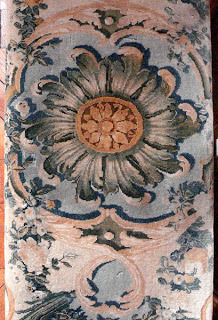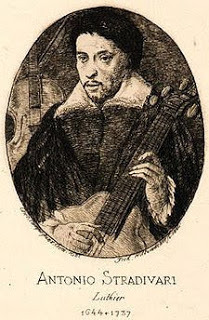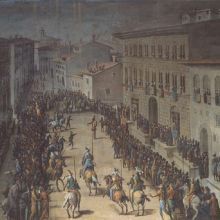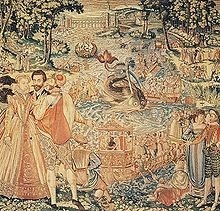Joyce Elson Moore's Blog, page 5
June 10, 2010
A Village Where No One Lives

In the west-central part of France, the town of Oradour, where no one lives, has been preserved in its abandoned state since 1944. While doing research for my historical novel, The Tapestry Shop, I came upon this once-thriving village, now a solemn reminder of WWII and innocent lives lost.
There is disagreement as to the exact reason for what took place, but the events that unfolded there are unquestioned. On a sunny morning in June, members of the 2nd SS Panzer Division Das Reich entered thi...
Published on June 10, 2010 11:23
May 27, 2010
The Orphans at Savonnerie

My current work-in-progress takes place in and around Paris, and concerns the orphans at the Savonnerie tapestry factory. Because I found the research so interesting, I thought I'd share a bit of it with my readers.
During the 15th century, Jean Gobelin founded a dye factory in Paris. Later, Henry IV took over the factory and turned it into a profitable tapestry factory. In 1601, the king brought two weavers from Flanders to Paris to manage the workshops, which were still known as the ...
Published on May 27, 2010 13:08
May 21, 2010
Tapestry and weaving has always held a fascination for me...

Tapestry and weaving has always held a fascination for me, even though I've never learned the craft. I've seen weavers at reenactments, and tapestries in museums, though. Many of them reflect the geographical location and time period in which they were created. If you google "tapestries" in Wikimedia Commons, you'll see what I mean. Those by Spanish artists are different from the French, just as painting style and medium differ.
Today, though, I'm blogging about a different kind of tapestry—o...
Published on May 21, 2010 14:01
May 11, 2010
Medieval Income Taxes
Papal taxes, begun in the 12th century, required Catholic clergy to pay one-fortieth of their income to support the crusaders. The practice was continued by later popes. Originally, the taxes went directly to the crusaders.

In the 13th century, the collection of taxes supported crusades outside the Holy Land, such as Pope Gregory IX's war against Frederick II, the Holy Roman Emperor. The taxes went straight to the pope to distribute as he saw fit, or in some cases, to a nobleman who promised ...

In the 13th century, the collection of taxes supported crusades outside the Holy Land, such as Pope Gregory IX's war against Frederick II, the Holy Roman Emperor. The taxes went straight to the pope to distribute as he saw fit, or in some cases, to a nobleman who promised ...
Published on May 11, 2010 13:14
April 29, 2010
A Stolen Stradivarius
There are several documented stories of stolen Stradivarius violins, but one of the most interesting was reported in the New York Times in 1996.
The violin thief, sitting in jail for having assaulted a child, told his wife to get his violin from a friend, and read the paper inside. She did, and it was an article about a Polish violinist whose Stradivarius violin had been taken from his Carnegie Hall dressing room while he performed on another instrument. The thief's wife asked if that was the ...
while he performed on another instrument. The thief's wife asked if that was the ...
The violin thief, sitting in jail for having assaulted a child, told his wife to get his violin from a friend, and read the paper inside. She did, and it was an article about a Polish violinist whose Stradivarius violin had been taken from his Carnegie Hall dressing room
 while he performed on another instrument. The thief's wife asked if that was the ...
while he performed on another instrument. The thief's wife asked if that was the ...
Published on April 29, 2010 18:50
April 19, 2010
Stradivarius Violins

Antonio Stradivari was born in Cremona, Italy, sometime around 1644, but the exact date of his birth is unknown. His life spanned two centuries, and he died in 1737.
Antonio was an Italian luthier, a craftsman of stringed instruments. He also made violas, cellos, and at least one harp. The Latin form of his name, Stradivarius, refers to his violins. Antonio had six children by his first wife, and five by his second. His sons worked in the shop, and some of the signed Stradivarius violins are ...
Published on April 19, 2010 05:18
April 10, 2010
Tapestry in Medici Florence

It is difficult to think of Renaissance art in Italy without the d'Medici family name coming to mind. In 15th century Florence, Cosimo d'Medici's patronage of the arts supported the work of Brunelleschi, Michelangelo, Botticelli, and others. Less celebrated are the Florentine tapestries. The Medici family supported tapestry workshops that thrived within the city. Tapestries were in demand to decorate the halls of new buildings as well as the palace itself.
The Florentine cartoonists (artists w...
Published on April 10, 2010 09:40
April 3, 2010
Easter in France begins with Fat Tuesday (Mardi Gras), a ...

Easter in France begins with Fat Tuesday (Mardi Gras), a part of Carnival. Because of France's strong Catholic tradition, their calendar observes the same days that Catholic churches all over the world do: Ash Wednesday, Lent, Holy Thursday, and Good Friday leading up to Easter.
Most Americans associate Mardi Gras with New Orleans, but the first Carnival was celebrated in Nice, France. Carnival in France lasts for two weeks, with parades, fireworks, and masked balls.
Since the 12th century...
Published on April 03, 2010 13:37
March 14, 2010
Tapestry in France
Hospices de Beaune, a former almshouse of the 15th century, is now a museum, one of the buildings in a complex that has grown since its early beginning.
Although the Hundred Years War officially ended with the Treaty of Arras in 1435, massacres continued, initiated by roving bands of misfits who roamed the countryside.
Burgundy was then rules by Philip the Good. His Chancellor, Nicolas Rolin, alarmed by the plight of the people in Beaune, decided to create a hospital for the destitute.

Published on March 14, 2010 13:46
March 7, 2010
Valois tapestries

As evident in my web design, I am fond of tapestries, and sat for a few hours to look at the Bayeux Tapestries in that dimly lit, cold room in France. I guess others have done the same thing, as there are bleachers to sit on while taking in the enormity of all that art.
This tapestry, adjacent, is part of the Valois Tapestries, one of a series of eight tapestries depicting events in the French court during the 16th century. It was possibly owned at one time by Catherine de'Medici, but was not ...
Published on March 07, 2010 14:38



